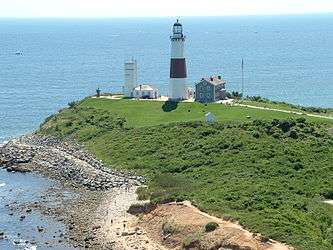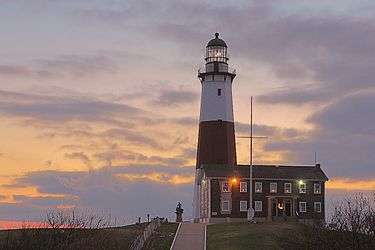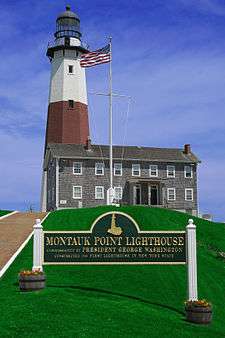Montauk Point Light
|
(2007) | |
| Location | Montauk Point, Suffolk County, New York |
|---|---|
| Year first lit | 1797 |
| Automated | 1987 |
| Foundation | 13 ft (4 m) deep and 9 ft (3 m) thick, Natural, Emplaced, built in 1796 |
| Construction | Sandstone |
| Tower shape | Octagonal pyramidal |
| Markings / pattern | Tower painted white with a broad red band midway, lantern black |
| Height | 110.5 ft (33.7 m) structure |
| Focal height | 168 ft (51 m) |
| Original lens | 8 whale oil lamps (1797), Fresnel lens |
| Current lens | VRB-25 |
| Range | 18 nm |
| Characteristic | Flashing White 5 seconds. |
| Fog signal | Horn: 1 2s in every 15s |
| ARLHS number | USA-512 |
| USCG number | |
|
Montauk Point Lighthouse | |
  | |
| Nearest city | East Hampton, New York |
| Coordinates | 41°4′15.480″N 71°51′25.528″W / 41.07096667°N 71.85709111°WCoordinates: 41°4′15.480″N 71°51′25.528″W / 41.07096667°N 71.85709111°W |
| Area | 0 acres (0 ha) |
| Built | 1796 |
| Architect | McComb,Jr.,John |
| NRHP Reference # | [3] |
| Significant dates | |
| Added to NRHP | July 07, 1969 |
| Designated NHL | March 2, 2012 |
The Montauk Point Light is a lighthouse located adjacent to Montauk Point State Park, at the easternmost point of Long Island, in the hamlet of Montauk in the Town of East Hampton in Suffolk County, New York. The lighthouse was the first to be built within the state of New York, and was the first public works project of the new United States. It is the fourth oldest active lighthouse in the United States.[4] Long listed on the National Register of Historic Places, in 2012, it was designated as a National Historic Landmark for its significance to New York and international shipping in the early Federal period.
The lighthouse, which is located on Turtle Hill at the easternmost tip of Long Island, at 2000 Montauk Highway, is a privately run museum, and is not part of Montauk Point State Park. Entry to the lighthouse costs $10.00 for an adult and $4.00 per child.[5]
History

Montauk Light was the first lighthouse in New York State, and is the fourth-oldest active lighthouse in the United States. The tower is 110'6" high. The current light, installed in July 2001, equivalent to approximately 290,000 candle power, flashes every 5 seconds and can be seen a distance of 17 nautical miles (31 km).[4]
Construction on the lighthouse was authorized by the Second United States Congress, under President George Washington on April 12, 1792. Ezra L'Hommedieu, a prominent lawyer, member of the Continental Congress,[6] and a man with scientific interests, consulted with Washington on its construction. He represented the New York City Chamber of Commerce on discussions related to the lighthouse. He made the case that New York City "was first among American ports in the volume of its foreign commerce. By 1797, the harbor was handling a third of the nation’s trade with other countries."[7] Due to prevailing winds in winter, shippers approaching from sea needed a lighthouse at the end of Long Island to guide them along the south side into New York harbor.[7]
L'Hommedieu chose the site for the lighthouse[8] and designed it.[7] The project began on June 7, 1796, and was completed on November 5, 1796, the first public works project of the new United States of America. Sometime in early April 1797, keeper Jacob Hand lit the wicks in the lamps in the tower, and the lighthouse began operation. It continued under civilian keepers until World War II, when the US Army took it over.[9]
In 1860 the lighthouse station underwent a massive renovation when two new levels and a larger lantern were added. This increased the height of the tower from its original 80 feet (1796) to its current height of 110' 6". A first-order Fresnel lens—12 foot high, 6 feet in diameter, and weighing about 10,000 pounds—was installed in the new lantern; the current keeper's dwelling was constructed adjacent to the tower, and the original 1796 dwelling demolished. A steam-powered fog signal was installed in 1873, with a fog signal building in 1897. The tower was originally all white; its single brown stripe was added in 1899. A fourth-order fixed red range-light was added to the watch deck of the tower in 1903 to warn of Shagwong Reef, a navigational hazard about 3 1⁄2 miles northwest of the lighthouse. This light was severely damaged in the hurricane of September 21, 1938 and removed on July 1, 1940 when the lighthouse was electrified. The huge first-order Fresnel lens was replaced in 1903 with a 3 1⁄2 order bivalve Fresnel lens, which served until February 3, 1987, when it was replaced with an airport beacon with a strength of 2.5 million candela.
During World War II, the lighthouse was taken over by the U.S. Army as part of the Eastern Coastal Defense Shield. The last three civilian keepers—Thomas Buckridge, Jack Miller, and George Warrington—departed in the spring of 1943. Adjacent to the lighthouse, Camp Hero was opened by the Army in 1942 and was heavily fortified with huge guns during the war. Those gun emplacements and concrete observation bunkers (which are also at nearby Shadmoor State Park) are still visible.
In 1946 the United States Coast Guard took over maintenance of the lighthouse and operated it until the station was automated on February 3, 1987. In May of that year, the lighthouse museum opened to the public, operated by the Montauk Historical Society. It leased the property from the US Coast Guard for that purpose. On September 30, 1996 President Bill Clinton signed legislation transferring the lighthouse property to the Montauk Historical Society.
The tower was built on Turtle Hill 300 feet (90 m) from the edge of the cliff; due to the cumulative effects of shoreline erosion, it is now 100 feet (30 m) away from the edge. After World War II, the United States Army Corps of Engineers built a seawall at its base, but the erosion continued. The Coast Guard considered tearing down the lighthouse in 1967 and replacing it with a steel tower further from the edge of the bluff. In the wake of protests over the announced dismantling of the tower, Congressman Michael Forbes proposed a bill to the United States Congress to hand over the Lighthouse to the Montauk Historical Society from the Public so it could be preserved;[10] the bill was passed.
Giorgina Reid (1908–2001), a textile designer, had saved her Rocky Point, New York cottage from collapse by building a simple set of terraces in the gullies of the bluff. She proposed that solution to the Society at Montauk. Reid's concept, Reed-Trench Terracing, called for building the terrace platforms made of various beach debris, notably reeds; the practice (along with further strengthening of the rocks at the bluff toe) appeared to stem the erosion. She patented the process and published an article about it titled "How to Hold up a Bank".[11] Greg Donohue, a Montauk landscaper, worked with Giorgina Reid at the Point and kept the project moving forward after she retired in 1986. With support from various sources, including the Montauk Historical Society and the State of New York, the Erosion Control Project of Montauk Point was successfully completed in 1998.
However, the recurrence of the erosion threat in ensuing years has prompted further action: In November 2006, the United States Army Corps of Engineers' plan to build another seawall was opposed by a local surfing group, who contended that a seawall would ruin the nearby world-renowned surf break. They proposed moving the lighthouse back from the shore, as was done with the Cape Hatteras Lighthouse.[12] Complicating such a move is the terrain, which would require the lighthouse to be moved down one hill and up another. Environmental groups have raised concerns that reducing the erosion at Montauk would increase erosion at other Long Island beaches, as there are always related effects to such infrastructure work.[13]
On March 2, 2012 United States Secretary of the Interior Ken Salazar officially designated the lighthouse as a National Historic Landmark; it is the 14th site on Long Island and the 11th lighthouse in the country to be so recognized.
Suffolk Transit's S94 bus route serves the lighthouse seasonally, connecting it with Montauk Village.
Pirate Captain Kidd was said to have buried treasure at the foot of the lighthouse site around 1699 at two ponds which today are called "Money Ponds."[14]
Gallery
- View from the top of the lighthouse.



References
Notes
- ↑ Light List, Volume I, Atlantic Coast, St. Croix River, Maine to Shrewsbury River, New Jersey (PDF). Light List. United States Coast Guard. 2009. p. 8.
- ↑ "Historic Light Station Information and Photography: New York". United States Coast Guard Historian's Office.
- ↑ National Park Service (2009-03-13). "National Register Information System". National Register of Historic Places. National Park Service.
- 1 2 "Lighthouse Facts". Montauk Light House.com. Retrieved 2008-06-24.
- ↑ "Let's Talk About Montauk". Retrieved 16 April 2012.
- ↑ Mac Griswold, The Manor: Three Centuries at a Slave Plantation on Long Island, New York: Farrar, Straus and Giroux, 2013, p. 263
- 1 2 3 Russell Drumm, "Turning a Montauk Beacon Into a Landmark", Easthampton Star, 2 June 2011, accessed 4 December 2013
- ↑ Henry Osmer, "Montauk Point Lighthouse Awarded National Landmark Status", Lighthouse Digest, Sep-Oct 2012, accessed 4 December 2012
- ↑ William G. Tyrrell (May 1969). "National Register of Historic Places Registration: Montauk Point Lighthouse". New York State Office of Parks, Recreation and Historic Preservation. Retrieved 2010-02-20. See also: "Accompanying photo".
- ↑ Montauk Point Lighthouse Museum (Local Legacies)
- ↑ "Against All Odds", Official Montauk Lighthouse website
- ↑ Kilgannon, Corey (November 14, 2006). "For Montauk, It's Lighthouse vs. Surf's Up!". The New York Times. Retrieved 2009-09-02.
- ↑ Dean, Cornelia (November 21, 2006). "The Coastline Is Retreating. Should the Montauk Lighthouse Stand Its Ground?". The New York Times. Retrieved 2009-09-02.
- ↑ Pirates and Prohibition - Excerpted From East Hampton History, by Jeannette Edwards Rattroy - 1953 (republished on longislandgeneology.com - Retrieved 2007-01-12)
Further reading
Books by Henry Osmers, published by Outskirts Press:
- On Eagle's Beak: A History of the Montauk Point Lighthouse, 2008.
- Living on the Edge: Life at the Montauk Point Lighthouse 1930–1945, 2009.
- They Were All Strangers: the Wreck of the John Milton at Montauk, New York, 2010.
- American Gibraltar: Montauk and the Wars of America, 2011.
External links
| Wikimedia Commons has media related to Montauk Point Light. |
- The Official Montauk Point Lighthouse Web Site
- National Park Service List of New York Lighthouses
- New York State Parks: Montauk Point State Park



